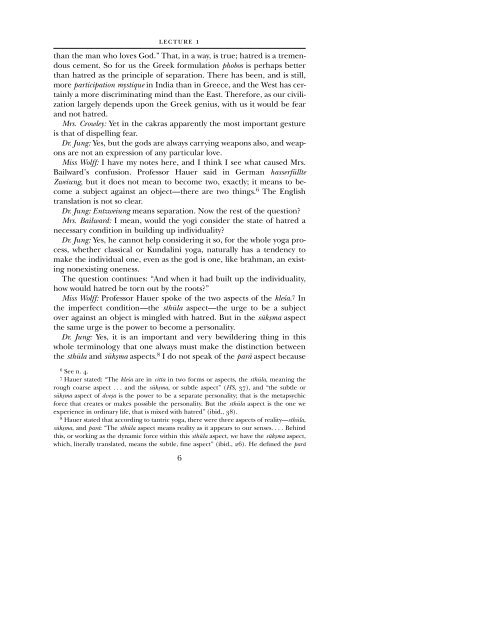CG JUNG - Countryside Anarchist
CG JUNG - Countryside Anarchist
CG JUNG - Countryside Anarchist
Create successful ePaper yourself
Turn your PDF publications into a flip-book with our unique Google optimized e-Paper software.
LECTURE 1<br />
than the man who loves God.” That, in a way, is true; hatred is a tremendous<br />
cement. So for us the Greek formulation phobos is perhaps better<br />
than hatred as the principle of separation. There has been, and is still,<br />
more participation mystique in India than in Greece, and the West has certainly<br />
a more discriminating mind than the East. Therefore, as our civilization<br />
largely depends upon the Greek genius, with us it would be fear<br />
and not hatred.<br />
Mrs. Crowley: Yet in the cakras apparently the most important gesture<br />
is that of dispelling fear.<br />
Dr. Jung: Yes, but the gods are always carrying weapons also, and weapons<br />
are not an expression of any particular love.<br />
Miss Wolff: I have my notes here, and I think I see what caused Mrs.<br />
Bailward’s confusion. Professor Hauer said in German hasserfüllte<br />
Zweiung, but it does not mean to become two, exactly; it means to become<br />
a subject against an object—there are two things. 6 The English<br />
translation is not so clear.<br />
Dr. Jung: Entzweiung means separation. Now the rest of the question?<br />
Mrs. Bailward: I mean, would the yogi consider the state of hatred a<br />
necessary condition in building up individuality?<br />
Dr. Jung: Yes, he cannot help considering it so, for the whole yoga process,<br />
whether classical or Kundalini yoga, naturally has a tendency to<br />
make the individual one, even as the god is one, like brahman, an existing<br />
nonexisting oneness.<br />
The question continues: “And when it had built up the individuality,<br />
how would hatred be torn out by the roots?”<br />
Miss Wolff: Professor Hauer spoke of the two aspects of the kleça. 7 In<br />
the imperfect condition—the sthÖla aspect—the urge to be a subject<br />
over against an object is mingled with hatred. But in the sÖküma aspect<br />
the same urge is the power to become a personality.<br />
Dr. Jung: Yes, it is an important and very bewildering thing in this<br />
whole terminology that one always must make the distinction between<br />
the sthÖla and sÖküma aspects. 8 I do not speak of the parv aspect because<br />
6 See n. 4.<br />
7 Hauer stated: “The kleça are in citta in two forms or aspects, the sthÖla, meaning the<br />
rough coarse aspect . . . and the sÖküma, or subtle aspect” (HS, 37), and “the subtle or<br />
sÖküma aspect of dveüa is the power to be a separate personality; that is the metapsychic<br />
force that creates or makes possible the personality. But the sthÖla aspect is the one we<br />
experience in ordinary life, that is mixed with hatred” (ibid., 38).<br />
8 Hauer stated that according to tantric yoga, there were three aspects of reality—sthÖla,<br />
sÖküma, andparv: “The sthÖla aspect means reality as it appears to our senses. . . . Behind<br />
this, or working as the dynamic force within this sthÖla aspect, we have the sÖküma aspect,<br />
which, literally translated, means the subtle, fine aspect” (ibid., 26). He defined the parv<br />
6


